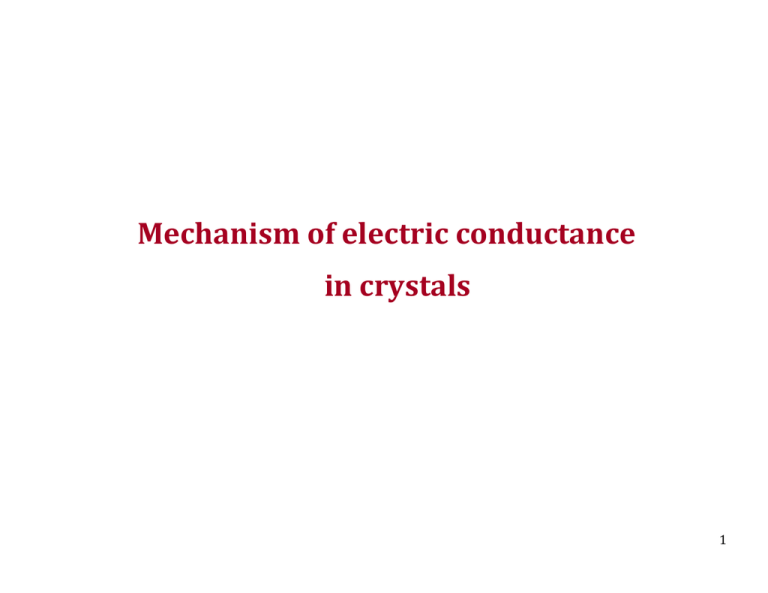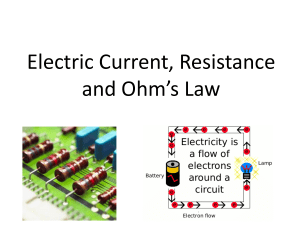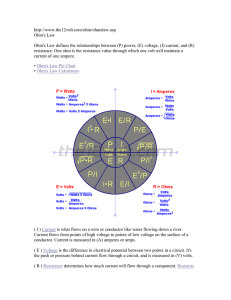Mechanism of electric conductance in crystals
advertisement

Mechanism of electric conductance in crystals 1 Electric current in conductors A When the conductor is in electric field, the field accelerates free electrons Electrons moving (drifting) in electric field transfer the electric charge. Moving electric charges create electric current through the conductor 2 Electric current in crystalline conductors - Electric Field Q I= t + + + Factors determining the electric current in crystalline conductors: 1. How many free electrons the crystal has 2. How fast the charge carriers (i.e. electrons) can move in the electric field 3 How many free electrons are there in the conductor? Metals have ~ 1023 atoms per 1 cm3 Every atom donates 1 free electron: Therefore, every 1 cm3 of the metal contains ~ 1023 free electrons n ~ 1023 cm-3 = 1023 (1/cm3) n is the electron concentration The concentration shows the number of particles per unit volume 4 Conductors, Insulators and Semiconductors Metal: ~ 1023 atoms per 1 cm3 Insulator: ~ 1023 atoms per 1 cm3; Semiconductor: ~ 1023 atoms per 1 cm3; Every atom donates 1 free electron: No free electrons: n ~ 1023 cm-3 Some atoms donate free electrons n~0 n ~ 1010 - 1019 cm-3 5 Example problem 1 The metal bar dimensions are 2mm x 3 mm x 0.5 mm; Free electron concentration in the metal is 2x1023 cm-3. How many free electrons the bar contains? 0 of 5 120 Timed response 6 Example problem 2 Thin-film wire is 2 µm thick, 5 mm long and 20 µm wide. Free electron concentration in the metal is 5x1022 cm-3. How many free electrons the wire contains? 0 of 5 120 Timed response 7 How fast the electrons can move: electron mobility in crystals Equilibrium condition, no electric field (voltage) applied Free electron experiences very frequent collisions with atoms in the metal. As a result it moves randomly (with the velocity of around 105 m/s). On average, the electron does not go anywhere! Average electric current is equal to zero (There is a flicker charge transfer, or the NOISE current though) 8 Electron in motion in conductors Electric field applied: There is an electric force, F = e E exerting on any free electron. Electron still experiences very frequent random collisions. However, after each collision the electron’s velocity has a component toward the positive electrode (against the field direction) On average, the electron drifts from negative electrode toward positive. There is a current flowing through the metal. 9 Electron mobility in crystals Let us ignore the random collisions and only monitor the drift in the electric field Ignoring the collisions, which are completely random, we can say that average electron velocity (drift velocity) is proportional to the electric field applied: v~E v=µE µ is called the electron mobility: µ = v/E [(m/s)/(V/m) = m2/(V.s)] 10 Electric current in conductors A Electron drift velocity increases with electric field: Electric current v=µE er h Hig en c on c n o r ct e l e n o i t tra Electric field 11 Mechanism of electric conductance ∆L = v.∆ t A E Gnome is counting the electrons A = wire cross-section area L n= free electron concentration, i.e. the number of electrons per unit volume If the conductor volume is A×L, the total number of electrons, N = n ×A×L In the ∆t time interval, how many electrons will cross the dashed area A? ∆Ν = n (v ∆t) A How much charge will pass through? ∆Q = e ∆Ν = e n (v ∆t) A; The electric current I= where e = abs (electron charge) ∆Q =env A ∆t 12 Mechanism of electric conductance v. E A A = wire cross-section area ∆Q The electric current I = =env A ∆t The electron drift velocity, v = µ E, from this, I = (e n µ A) E Electric current is proportional to the electric field (external parameter) Electric current is proportional to n, µ and A (conductor parameters) 13 Mechanism of electric conductance E v. A 1. The external power source (the battery) creates a potential difference along the conductor: V; 2. The potential difference (the voltage) creates an electric field across the conductor E = V/L; 3. Electric field accelerates free electrons and produces the current I = (e n µ A) E Using E = V/L: A A I = e n µ V = e n µ V L L 14 Mechanism of electric conductance A A I = e n µ V = e n µ V L L This product contains only the material parameters, does not depend on applied voltage or on the geometrical shape of the conductor. It is called conductivity: σ =enµ Material properties are also often characterized by resistivity: 1 1 ρ= = σ enµ 15 Using conductivity or resistivity the current – voltage relationship is: A I =σ V L The term 1 A ⋅ ρ L or 1 A I= ⋅ V ρ L does not depend on the applied voltage but only on the material properties and the sample dimensions. L is called resistance. R= ρ⋅ A Using the resistance, the I-V relationship is: 1 I= V R or V =I ⋅R These two relationships are called the Ohm’s law 16 The Ohm’s Law George Ohm has established experimentally in 1827 the following law V is the voltage across a conductor I is the current thought a conductor 1/R is a proportionality factor; R is called “resistance” + I V Electric current 1 I= V R r s s Le e ce n ta s i s Voltage 17 Ohm’s Law and electron charge transfer rate comparison 1 I= V R r e gh i H ele ra t en c n o c n o r t c it on Electric field Electric current Electric current v=µE r s s Le e ce n ta s i s Voltage 18 Experimental observations of Ohm’s Law Electric current 1 I= V R Voltage Conductor length decreases Current increases, i.e. R decreases 19 Experimental observations of Ohm’s Law Electric current 1 I= V R Voltage Conductor area increases Current increases, i.e. R decreases 20 Ohm’s law, resistance and resistivity - summary I =V R V = I ×R R= ρ L A Ohm’s law in the form of I(V): the current through the conductor = applied voltage divided by the resistance Ohm’s law in the form of V(I): the voltage needed to maintain the current I = current times resistance. L is the length of the conductor in the direction of the current flow; A is the cross-section area; L R=ρ A ρ describes the material ability to conduct the current. The higher ρ is, the higher R and the lower the current 1 ρ= enµ 21 The units for resistance and resistivity V R= I V = I ×R Resistance R is measured in Ohms (Ohm, Ω) 1 Ohm is the resistance of the sample that passes the current of 1A when the voltage of 1 V is applied across it. L R=ρ A A m2 ρ =R Ohm = Ohm ⋅ m L m Resistivity is measured in Ohm - meters (Ohm· m) 22 Ohms’ law using conductance and conductivity Conductance G =1 / R Using the conductance, the Ohm’s law can be written as I = G ⋅V Also, from G =1 / R σ= 1 ρ =enµ L and R = ρ , A 1 A G =1 / R = ρ L σ is the conductivity of the material (does not depend on the conductor shape) Using conductivity, the conductance of the sample is given by A G =σ L 23 Ohm’s Law using conductance - summary The expression that relates the electric current to the applied voltage is called the Ohm’s Law (established experimentally in 1827) I = G ×V , where A G =σ L σ =enµ is the conductance of the sample (wire), is the conductivity of the material A is the conductor cross-section area; L is the conductor length along the current direction n is the concentration of free electrons µ is the electron mobility 24 The units for conductance and conductivity I = G ×V I G= V Conductance is measured in Siemens (S) 1 S is the conductance of the sample that passes the current of 1A when the voltage of 1 V is applied across it. G =σ A L L m σ =G S = S / m A m2 Conductivity is measured in Siemens per meter (S/m) 25 Ohm’s Law in the differential (“microscopic”) form: I = (e n µ A) E where A is the cross-section area, E is the electric field in the conductor or I = σ AE where σ = enµ is the conductivity of the material or V I=σ A L where V is the voltage across the conductor and L is the conductor length in the direction of current flow 26 Problem 3. What is the current in the circuit below? 1. 2. 3. 4. 3A 4A 36 A 12 A 60 0% 1 0% 0% 2 3 0% 4 27 Resistivity of different materials Wires are used to connect different components in the network; Wires have very low resistance Resistors are used to dissipate the power and to change the voltage (potential). Material Electric Resistivity (×10-9 Ohm·m) Aluminum [Al] 27 Aluminum Alloy 50 Brass 20 - 61 Carbon [C] 1.4 × 104 Copper [Cu] 17 Copper Alloy 17 - 490 Gold [Au] 24 Iron [Fe] 97 28 Problem 4. Find the resistance of a wire made of copper [Cu] (ρ = 17*10-9 Ohm-m). The wire is 1 m long and is 1 mm in diameter. 1. 0.043 Ohm 2. 2.17*10-2 Ohm 3. 1.39 *10-2 Ohm 4. 435 S 180 0% 1 0% 0% 2 3 0% 4 29 Solution Find the resistance of a wire made of copper [Cu] (ρ = 17*10-9 Ohm-m). The wire is 1 m long and is 1 mm in diameter. R = ρ *L/A L = 1 m; D = 1mm = 10-3 m; The area, A = π*D2/4 = 3.14*(10-3)2/4 = 7.85*10-7 m2 The resistance R = 17*10-9 Ohm*m*1m/ 7.85*10-7 m2 = 2.17*10-2 Ohm = 21.7 mOhm Find the voltage across this wire, in the current through it is 1 A V = I ×R = 1 A × 21.7 m Ohm = 21.7 mV Conclusion: wires do not change the potentials in the circuit; Voltage across the wire can be taken as 0 in most problems 30 Problem 5. Find the resistance of a carbon resistor (ρ ρ = 1.4 × 10-5 Ohm*m), that is 1 cm long and 0.1 mm in diameter 1. 2. 3. 4. 0.178 Ohm 17.8 Ohm 1.78 Ohm 0.0178 Ohm 180 0% 1 0% 0% 2 3 0% 4 31 Solution Find the resistance of a carbon resistor, which is 1 cm long and 0.1 mm in diameter R = ρ *L/A; ρ = 1.4 × 104 * 10-9 Ohm*m = 1.4 × 10-5 Ohm*m ; L = 1 cm = 10-2m; A = 7.85*10-9 m2 R = 1.4*10-5 Ohm*m*10-2 m/ 7.85*10-9 m2 = 17.8 Ohm Compare: Cu – wire, R1 = 21.7 mOhm ≈ 0.02 Ohm; Carbon-resistor, R2 = 17.8 Ohm ≈ 18 Ohm; Given electric circuit with the current of 1 A, the voltage drop across the Cu- wire, V1 = I*R1 = 0.02 V; The voltage drop across the Carbon-resistor, V2 = I*R2 = 18 V; Resistors significantly change the potentials in the circuit. 32 Problem 6. Two wires are made of the same material. The lengths and the diameters are as follows: Length Diameter Wire 1 10 cm 1 mm Wire 2 20 cm 2 mm Which wire, #1 or #2, has higher resistance? 1. Wire #1 2. Wire #2 3. Equal resistances 0% 1 0% 2 0% 3 120 33 Problem 7. The bar made of carbon (ρ = 1.4 × 10-5 Ohm*m) The current flows through the bar in the direction shown by a blue arrow. L = 10 cm; W=5 mm; d = 2 mm. What is the resistance of the bar? d L I W 1. 5.6e-5 Ohm 2. 0.14 Ohm 3. 3.5e-4 Ohm 0% 1 0% 2 0% 3 180 34 Problem 8. The bar made of carbon (ρ = 1.4 × 10-5 Ohm*m) The current flows through the bar in the direction shown by a blue arrow. L = 10 cm; W=5 mm; d = 2 mm. What is the resistance of the bar? I d L W 1. 5.6e-5 Ohm 2. 0.14 Ohm 3. 3.5e-4 Ohm 0% 1 0% 2 0% 3 180 35 Problem 9. What voltage is needed to generate the current of 2A in a resistor of 100 Ohm? 1. 2. 3. 4. 50 V 2V 200 V 25 V 60 0% 1 0% 0% 2 3 0% 4 36 Problem 10. What voltage is needed to generate the current of 2A in a resistor of 0.01 Ohm? 1. 2. 3. 4. 0.2 V 0.02 V 20 V 25 V 60 0% 1 0% 0% 2 3 0% 4 37







